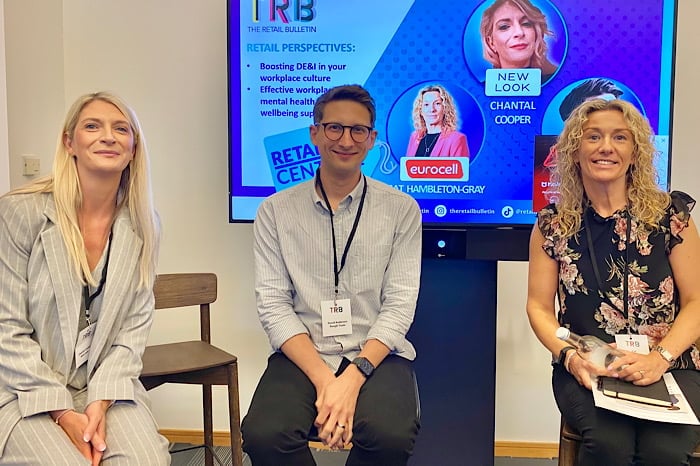Conference review: HR Central
Pressures on the labour market remain incredibly acute in the retail sector but it can be alleviated by a more personalised approach to recruitment and a stronger focus on looking after employees once onboard through embedded wellbeing strategies.
These messages came out strongly at the recent The Retail Bulletin Retail HR Central conference in Birmingham to a room packed full of delegates, with Darren Sanderson-Williams, general manager at Specsavers, suggesting to those gathered that clearly high up the HR agenda is the hiring of talent and retaining it and that at Specsavers the company’s incredibly strong culture is a vitally important dynamic. This includes projecting its image and values into the marketplace.
This is a task that has been embraced by David Nottage, head of talent attraction & acquisition at Footasylum, who says he has built a recruitment strategy at the footwear business around using social media to tell stories. “The team have to be talent acquisition and marketers. We post stories including ones about existing people in the company. We don’t want to be selling the business when people apply, it needs to have already been done,” he says.
It is a similar approach taken by Sally Price, global talent acquisition associate at Astrid & Miyu, who says: “Through our content, people can see what it’s like to be at Astrid & Miyu. People can view content and align with it, which then creates the drive for people to apply to work here. We’ll do office Tik Tok posts where it’s not just selling products. It’s about the human touch.”
Using social media has also been integral to the company’s application process that constantly evolves, with its ATS (Applicant Tracking System) allowing lots of different content to be included in job applications.
“We try to make the process as fun as possible, it’s not just about a CV but it could be Instagram Reels, a voice note or video. This appeals to people who are terrified by a cover letter. The interview process is all about values and life stories,” explains Price.
Such has been the success of the storytelling approach, which has driven incredible levels of applications at Footasylum, that Nottage jokes his team have become “talent refection specialists”. Before the changes were implemented 70 applicants applied for 40-plus jobs whereas recently 16,500 people applied for 46 roles across the company. This has helped it reduce its reliance on job boards, with 64% of people now coming to the company organically.
Keeping it in-house
Although Carrie Westwell, head of HR at Bensons for Beds, recognised that successful recruitment comes from telling your story and people buying into it this was being held back by the company’s use of third-parties such as agencies to help it fill the urgent gaps in its workforce. Since joining the business she has looked to reduce the agency spend that “was through the roof” and put new processes in place to increase the amount of direct hires by 30% and cut by £1,500 the cost to recruit each person.
Reducing the reliance on agencies was also important to Marco Galer-Reick, vice president for UK strategy enablement & HR at Delaware North – that handles food, hotel and venue management across many businesses including Wembley Stadium, who says: “You get into the habit of spending millions when it should be about mobilising your business. They are not our people and do not live our values so we set a target of reducing agency costs by 25% and we’ve over-delivered on this.”
Values are vital to Deborah Ormondroyd, head of retail at Bird & Blend, and these are effectively helping her handle the challenge of constantly recruiting for a business that is growing – eight new stores will be opened this year and the same number each year after that. Her approach is to actively employ neurodiverse people.
“We take people on even if they have no experience. The language we use in our advertising can appeal to specific audiences. DEI (Diversity, Equity, Inclusion) is a core part of our business and we wouldn’t be who we are if we didn’t appeal to these audiences. It’s what we are as a brand,” she explains.
Understanding your company’s community
Chantal Cooper (pictured left), people experience manager at New Look, says the company went down the line of DEI over two years ago and began with capturing colleagues’ data, which has allowed the company to see how its community is made up. She admits it has been difficult although so far a credible 76% of employees have signed up to sharing their data. “We have focused on listening to colleagues through the data. We listen to the community and build a network of colleagues outside the business and also external experts,” she says.
Such initiatives only work with the support of senior executives, according to Cat Hambleton-Gray (pictured right), people director at Eurocell, who says they must set the example in opening up even if they find it challenging.
“Senior leaders’ roles are pivotal. Shared experiences have to come from the senior leaders, who drive DEI. They need to be more open. It’s not just talking about doing it but actually doing it. It’s difficult for ego-driven leaders but with coaching it can be done. We’ve had people who’ve said they’ll back it [a DEI strategy] but not take part. You have to chop-away at this but it is hard,” she explains.
David Anderson (pictured middle), head of people in the UK at Rough Trade, agrees: “You need openness and transparency at the top. If it’s not discussed from the top down then it won’t cascade through the whole business. It needs to be visible at all levels.”
He feels there is still a great amount of stigma about mental health and that Rough Trade works closely with the charity CALM who deal with suicide. “There has been employee buy-in with the work we do with the charity so that helps with talking about it,” says Anderson, who suggests one of the problem areas of mental health that is more prevalent than people think is burnout.
More care needed
This is an area that is very close to home for both Rob Savin, co-founder of Super Infinite, and Gareth Jones, founder of White Mirror, who have both suffered from burnout in previous roles and gave extremely open and honest presentations as they shared their difficult experiences.
Both were running departments at the sharp-end of e-commerce during Covid-19 when online was the only channel for retailers to trade through. This led to their workloads and stress levels becoming unsustainable. Savin says: “We were working hard just to keep the business afloat and although I was trying to avoid micro-management [of new recruits] I could not afford to give them that space. I was protecting them but also having to answer to the board at the same time.”
Jones recalls equally difficult times and he now acknowledges he had become a workaholic, which led to a breakdown: “I felt fragile and exhausted. I blamed myself when performance suffered and I got imposter syndrome….You don’t see yourself as having a problem. Taking time off did not help and I tried to push through it. You need to take time to recover properly and then set goals of achievement and to not go beyond them,” he recommends.
Being clear on people’s roles would no doubt help many people navigate much better their time in retail businesses, according to Charlotte Rees-John, head of retail, Leisure & hospitality Sector and employment partner at Irwin Mitchell, who says a lack of clarity can make it difficult for people to feel comfortable and achieve things in their jobs.
She also highlights the frequent problem of promotions into management of people who are possibly ill-suited to the roles but who also suffer as a result of a failure of companies to help them adapt to their new roles. “Equip managers correctly or do not appoint them in the first place is good advice,” she suggests.
Communication needs improving
Rees-John also touched on the sensitive subject of poor performance and how this should be handled. It is about companies having conversations with the person because a person ill-suited to a role has ramifications for not only that individual but also for the rest of their team. “It’s not about managing them out of the business. It’s about business improvement management,” she says.
As Rees-John points out, what is undoubtedly required in retailers is successful communications across all business functions. Statistics shared by Anna Rasmussen, founder & CEO of OpenBlend, highlights how tough the challenge can be. As many as 69% of managers are uncomfortable communicating with employees and only 6% of managers feel they are skilled at having candid performance conversations with employees.
Despite the difficulty the value is incredibly high as 60% of employees say feeling more valued is a top factor in encouraging them to stay with their existing employer. Jo Coxhill, organisational culture consultant at Vision 29, says: “Internal communications is needed for a strong culture.
Overwhelming disengagement is a major challenge for companies, especially with store-based employees who are busy and have no access to information. It can be endemic through whole organisations to be overwhelmed and disengaged.”
Giving employees a voice
She suggests simply giving employees a voice can be a major first step. “What are their problems, challenges? Just being heard means people will feel more valued. Communications then have to be straight to the point, what’s in it for them, and no fluff. There is no time or desire to engage with this [fluff] for in-store employees. HR, communications and leaders need to spend time in the stores,” suggests Coxhill.
A listening culture for Sacha Harvey, people director at Lucky Saint, has involved the adoption of a strengths-based business approach whereby the company, as much as possible, lets people dial-up on the things they are good at within their role. However, she admits it can be hard to build such a model because it can involve people doing only the things they like. Lucky Saint has also adopted a model of involving a wellbeing goal along with a results goal for its employees.
For Sarah Duxbury, global head of learning, OD & talent at All Saints, an important way to develop better engagement with employees is through Learning & Development, which she says is often not communicated outside the business enough. “People want to see the opportunity to develop. Do your teams talk about L&D on Linkedin etcetera,” she asks.
One aspect she recommends is to investigate apprenticeships, which can be beneficial to larger companies who pay the Apprenticeship Levy. She has found offering apprenticeship training – initially for leaders and senior management – has helped reduce employee turnover from 70% to under 50% and driven other engagement benefits.
Investing in people technology
What can also help employees on the shop-floor is technology, according to Paul Ridings, global director of growth for people at OneAdvanced, who says that these “desk-less” people make up 48% of employees in the retail industry and a growing amount of investment is going into what he describes as People Tech – comprising existing players and new technology providers.
“The top two biggest goals for retail executives [according to Forrester] are growing revenues and improving profits. Where are the people in this? The most mature retail businesses are seeing employee experience and customer experience as the biggest levers to pull and the most successful retailers are those investing in people technology. There has always been a return [on investment] from these products. Consider payroll for instance, errors in this can cost money. What’s not accepted yet is getting people up the investment agenda of retailers,” he argues.
Join us at our Retail HR Summit on 9 October in London. Book your free tickets here














